6 first-hand reviews of beef cow confinement
A panel of beef industry experts provides practical, firsthand insight on intensified cow-calf production.
December 2, 2014

Confinement — or intensification — of cow-calf production isn’t a spanking-new concept. In fact, the very first issue of BEEF magazine more than 50 years ago carried a report on cow-calf production in drylot being researched at Texas Technological College, now Texas Tech University. One driver of the research, the article says, was a desire to mitigate the land costs of the day, which researchers estimated were $1,200-$1,500/cow.
These days, those capital requirements for land are more in the neighborhood of $20,000-$30,000/cow if you’re talking deeded land in the Far West, says Kenneth Eng, longtime consulting nutritionist and the benefactor of the Dr. Kenneth & Caroline McDonald Eng Foundation. He calls intensification of cow-calf production, “a wonderful way for a young person to get started in the cow business, while established producers can purchase and expand their cowherd when cow prices are low due to short pasture conditions.”
Practical application of the intensification concept was the focus of a panel discussion during the second annual Dr. Kenneth & Caroline McDonald Eng Foundation Symposium held in San Antonio, TX, in September. Hosted this year by Texas A&M University (TAMU), the meeting is the public showcase for research conducted under Eng’s $2 million endowment to fund cow efficiency research at three universities: TAMU, Oklahoma State University (OSU) and the University of Nebraska.
A centerpiece of that research has been confinement — or intensification of — cow-calf production. Addressing their practical experience with intensified cow-calf production was a panel that consisted of:
• Ron Crocker, managing partner, CA Cattle Co., Mason County, TX
• Bill Dicke, consulting nutritionist, Cattlemen’s Nutrition Services, Lincoln, NE
• Dave McClellan, consulting nutritionist, McClellan Consulting Service, Inc., Fremont, NE
• Jim Simpson, consulting nutritionist, Simpson Nutrition Services, Canyon, TX
• Paul Defoor, senior vice president and chief operating officer of Cactus Feeders Inc.
Ron Crocker
Ron Crocker and his son Justin are situated in the Texas Hill Country of Mason County. The duo was buying 500-550-lb. calves and selling them as feeders when the senior Crocker foresaw calves moving toward $2/lb. “I said, ‘Let’s start buying cows.’ ”
Part of that gearing up included 150 cows they rotationally grazed on a 450-acre parcel, on which they previously grazed light feeders. “In our rotation, we set out one pasture, or move, that is basically a feed pen. We strategically feed these cows, even on the grass. Right now, we’re sitting on 98% breed-up weights and weaning 93% of the calves. We’re really happy with that.”
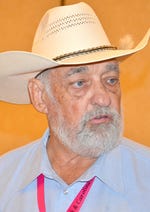
Ron Crocker
Crocker says a key to making the system work was settling on a cow condition they wanted to maintain via feeding; they weighed the cows every 21 days. “We arrived at a ration of 12½-14 lbs. of dry matter/day depending on their intake of a 47% burr ration,” Crocker says. “That’s what we fed them in this feeding pen.”
He says the operation is working to split up the labor by developing both a spring and fall calf crop, shooting to produce 550-lb. calves for both markets.
Bill Dicke
Consulting nutritionist Bill Dicke reports that more of his clients are adapting different forms of confinement production for various classes of cattle. “In addition to the standard cow operation, we’re seeing more replacement-heifer development on both a small and large scale. And one client is involved in a very large export program that has been very successful,” he says.
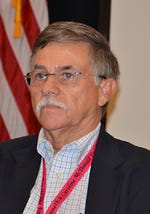
Bill Dicke
Dicke believes the intensification concept is gaining momentum, and its timing is good. “If young people can work out a way to work with a feedyard, or perhaps an older stockman, and own some cows without having to have a huge land base, it’s a great way to get new blood into the industry,” he says.
“You need a couple of things to make this work. One of the key ones is a cheap filler of some kind because 50%-75% of your diet is going to be some low-quality roughage combined with a higher-protein byproduct. So if you’re in an area that doesn’t have either of those, you’re facing a little different scenario,” Dicke says.
Dave McClellan
Consulting nutritionist Dave McClellan got started with cows in confinement about six years ago in Colorado “quite by accident,” he says, when a feedyard client was approached by a fraternity brother facing the prospect of a forced liquidation of his herd due to drought. Luckily for the cowman, his friend had empty pen space and a silage pile.
“Those cattle came to the feedyard and we worked out a program after consulting with Eng and Crocker, who I knew were feeding cows in confinement. That rancher has continued to ranch, and, since then, he’s even bought some dispersion cows out of drought areas and started doing confinement feeding himself,” McClellan says.
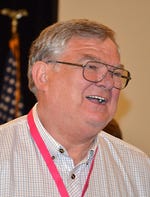
Dave McClellan
McClellan says his client base consists basically of multigenerational, family-owned, farmer-feeder operations with one-time feeding capacities of 5,000-12,000 head and who farm 8,000-15,000 acres. Among his clients, he estimates there are a total of about 5,000-6,000 head of cows maintained in some degree of confinement.
“These folks have the pen space and crop residue. They also are family operations and want to keep their workers gainfully employed,” McClellan says.
He says these farmer-feeders have evolved their confinement cow programs so that the cows calve in late May and June, or late August to October, to better dovetail with the seasonal farming schedule. Multiple breeding herds also allow better use of bulls.
McClellan is pleased with the results. “Our breeding rates are excellent; in many places, we’re down to less than a 60-day breeding season. We target 60 days, but quite often have the bulls out of there at 45-50 days,” he says. “We’re doing a better job of feeding the cow and meeting her needs, and helping that maternal immunity that gets passed to that calf.”
Jim Simpson
Consulting nutritionist Jim Simpson has a client base centered in the Texas Panhandle, Oklahoma and Kansas. He says his experience with confined cows prior to the 2010-2011 drought was feeding packer cows for 40-90 days. “But with the drought, things got really bad. These guys were forced into decisions they didn’t want to make, and there weren’t any real good ones.” The options included liquidation, sending cows to slaughter, or moving them at tremendous freight cost to areas with feed.
“A couple of ranchers approached feedyards I work with and asked if we could do something. These operators had genetics that they had acquired over decades, and they didn’t want to waste that effort,” Simpson says.
One drawback to his locale compared to the Midwest is a dearth of crop residues, as most of the fall crops are removed and the planting of wheat pasture immediately follows. However, the Panhandle does boast a lot of cotton and cotton byproducts. While they don’t carry much nutritional value, they serve as a great filler, Simpson says.
His experience with limit-feeding calves in the feedyard indicates that maintenance requirements can be reduced by as much as 15%. However, he says the overall savings in efficiency have been greater than anticipated.
“We’ve learned a lot. We can maintain a cow body condition score [BCS] of 4.5 to 5.5 pretty easily, and the cows seem to be very content. We’ve also found that calves consume feed very quickly after they’re born, and will consume feed next to their mother.”
Simpson says his formula provides 3 ft./animal of bunk space, which he says is a limitation to filling feedlot pens. “Typically on a finishing program, we’re 9-10 in. of bunk space, with 150 to 180 sq. ft./animal. So bunk space is my limitation.”
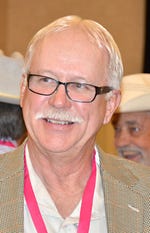
Jim Simpson
Calving is done in the pens, he reports. “We were very concerned about respiratory issues, and possibly some gut-health issues, but they haven’t been there. We’ve lost more calves to predators than disease. To be fair, this was in the middle of a drought, so mud wasn’t much of an issue.
He advises bedding pens in wet conditions during calving, “Ideally, you’d want a pasture or paddock to put them on,” he adds.
While much has been learned about cow intensification, Simpson says much more is yet to be explored. “Can I compromise BCS on that dry cow and save on feed costs without affecting long-term production? Is there an exercise requirement for a beef cow? If I’m going to keep her in a pen, she’s not going to get much exercise at all. Will I have issues with hoof growth, where I’m required to trim hooves on some of these long-term programs? We don’t know at this point,” he says.
Another issue with confining cows in a finishing lot, Simpson says, is that traditional equipment isn’t geared to a mature cow’s body weight. Overall, however, he’s happy with the results in the five client yards that have delved into some level of cow confinement. He estimates annual feed costs to be $400/year for a fully confined cow, which doesn’t include expenses, yardage or margins.
Paul Defoor
Paul Defoor, senior vice president and COO of Cactus Feeders Inc., says the ultimate goal of cow intensification for Cactus is “to grow the cowherd.” The operation began working with confined cows about six years ago, he reports. Serving at that time as director of strategy and business development, he says Cactus looked at intensification as a business development opportunity.
“We thought we could drylot cows and produce calves in confinement because our long-term projections were that the cowherd was in for a pretty rough ride.” Today, Cactus has about 8,000 breeding females located at a former feedlot facility in Syracuse, KS. The general manager of the Cactus Cow-Calf Division is Roberto Eizmendi.
During the recent prolonged drought, Defoor says Cactus averaged about $1.50/cow/day in feed costs, with a total enterprise cost of about $2/head/day. “That’s what it cost us to produce a calf essentially, and that’s fully loaded with cow depreciation, feed, labor, lease, with all the overhead items that would go into running a cow operation like that. At $2/day for 365 days/year, that’s a favorable margin for calves in the market we’re in today.”
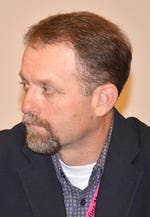
Paul Defoor
Defoor says Cactus has enjoyed “very solid health performance” with intensified production. “That’s not to say there won’t be an event from time to time, in terms of calf scours or something of that nature, but such events tend to be sporadic. But we haven’t observed that in Syracuse, KS; it’s a fairly dry climate, and there’s a lot of slope in the feedyard that we have those cows in.”
Shade is part of each pen. The facility uses structures they call “trampolines,” frames of 30-ft. lengths of 2 3/8-in. drill-stem pipe, with shade fabric stretched over them “at normal trampoline height,” Defoor says.
“The calf can get under the shade, but the cow can’t. We structure those in the pens and block off about a 40-50 ft. section of the concrete feed bunk so that when we feed the cows we can also feed the calves, and bring their creep supplement to put on top of that. Calves can get into that creep area and get some shade, while cows are kept out of the area. That seems to work pretty well,” Defoor says.
Editor’s note: The 2015 symposium will be hosted by Oklahoma State University in Oklahoma City’s Brickyard area the week of Sept. 14, 2015. For more information, call 575-743-6331 or email [email protected].
Copies of Kenneth Eng’s book, “Started Small & Just Got Lucky,” can be ordered via that contact information as well, or send $19 for each book to Dr. Kenneth & Caroline McDonald Eng Foundation, P. O. Box 272, Winston, New Mexico 87943. All proceeds go to the Dr. Kenneth & Caroline McDonald Eng Foundation.
About the Author(s)
You May Also Like


.png?width=300&auto=webp&quality=80&disable=upscale)
